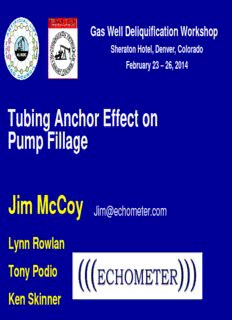
Heavy Wall Separator Above Tubing Anchor Casing Tubing Gas Separator Tubing Anchor Casing ... PDF
Preview Heavy Wall Separator Above Tubing Anchor Casing Tubing Gas Separator Tubing Anchor Casing ...
Gas Well Deliquification Workshop Sheraton Hotel, Denver, Colorado February 23 – 26, 2014 Tubing Anchor Effect on Pump Fillage Jim McCoy [email protected] Lynn Rowlan Tony Podio Ken Skinner Gas Separator Overview • Natural Gas Separators • Poor Boy Separators • Modified Poor Boy Separators (Collar Size) • Packer Type Separators • Special Separators (Twister, Cups) Many gas separators are too long and are poorly designed and constructed (torch). Feb. 23 - 26, 2014 2014 Gas Well Deliquification Workshop 2 Denver, Colorado Downhole Gas Separator Principle of Operation The outer pipe can be the casing or the outer Gas Separator barrel of a gas Liquid Capacity separator. The inner is Based on the tube is the inlet to the Following pump. Principle: 1/4 INCH DIAMETER GAS BUBBLES FLOW UPWARD IN OIL OR WATER AT A RATE OF APPROXIMATELY 6 INCHES PER SECOND. THUS, GAS BUBBLES WILL BE RELEASED FROM A LIQUID COLUMN IF THE DOWNWARD LIQUID VELOCITY IS LESS THAN 6 INCHES PER SECOND. A LIQUID COLUMN HAVING AN AREA OF 1 SQUARE INCH TRAVELLING AT 50 . 6 INCHES PER SECOND IS A FLOW RATE OF BPD Feb. 23 - 26, 2014 2014 Gas Well Deliquification Workshop 3 Denver, Colorado What Kind of Separator is Needed? ESP is Producing 5MMCF/D Well Measurements must be performed. 4 Natural Gas Separator The most efficient downhole gas separators locate the pump intake below the lowest gas entry point. Gas is not pulled down to the pump perforations unless the liquid velocity is greater than 6 inches per second. Maximum capacity is obtained using casing annulus. Feb. 23 - 26, 2014 2014 Gas Well Deliquification Workshop 5 Denver, Colorado Tubing Conveyed Downhole Separator System Gravity separation is the Pump governing principle for downhole gas separators. Insert Separator has less Separator capacity than using the casing ID. openings Downward Liquid velocity Outer barrel greater than 6 inches per second in separator pulls gas into pump. Dip tube Feb. 23 - 26, 2014 6 Sorry “Poor Boy” Gas Separator Seating Nipple Limited Flow Area Collar and Small Holes Casing Tubing Collars Perforated Sub prevent perforated sub Dip Tube from laying against casing Collar wall where liquid Joint of Tubing accumulates Feb. 23 - 26, 2014 2014 Gas Well Deliquification Workshop 7 Denver, Colorado Modified Poor Boy Separators The outer barrel is commonly enlarged for greater liquid/gas separation capacity. The space between the outer barrel and the casing should not result in fluid flow in the casing annulus past the ports greater than 10 feet per second. The outer barrel ports should be machined so that the edges are smooth. Do not use a welding torch to cut the ports. The dip tube should extend about 4 feet below the outer barrel perforations…excessive length will reduce efficiency. The lower portion of the outer barrel is used for sand and debris collection…the bottom must be closed with orange peel or bull plug. A collar on the bottom of the outer barrel can be removed to allow a joint of tubing to be placed below the outer barrel for additional sand collection capacity…the bottom must be closed. 2014 Gas Well Deliquification Workshop Denver, Colorado Collar Size Separator Increases Pump Fillage A good separator must balance annular flow area, separator flow area, dip tube diameter and pressure drop. Outer barrel OD same as collar OD. Thin wall outer barrel and short dip tube. Large inlet ports distributed around outer barrel facilitate entry of liquid. 2014 Gas Well Deliquification Workshop 9 Denver, Colorado The Collar-Size Separator The 5 foot long collar-size separator is optimized for the separation of gas and liquid. More area between the outer barrel and the dip tube is obtained by using a larger ID outer barrel for additional gas and liquid separation capacity. Each square inch of area had a separation capacity of 50 BPD. A dip tube length is optimized that results in a free gas and liquid separation length that is long enough to separate most of the free gas from the liquid yet is not excessively long to cause excessive friction loss that results in solution gas being released from the oil. The internal diameter and short length of the dip tube results in a friction pressure drop of less than 1 psi so minimum gas is released from the oil. A joint of tubing can be run below the separator for a sand and debris catcher.
Description: